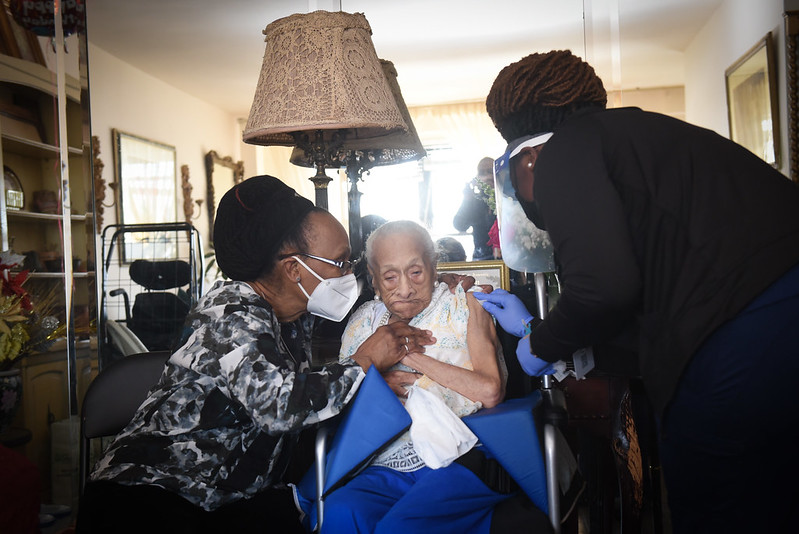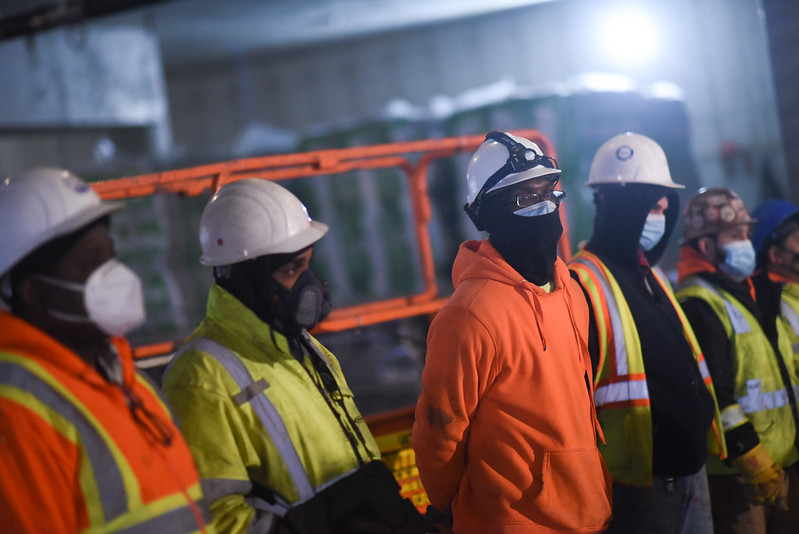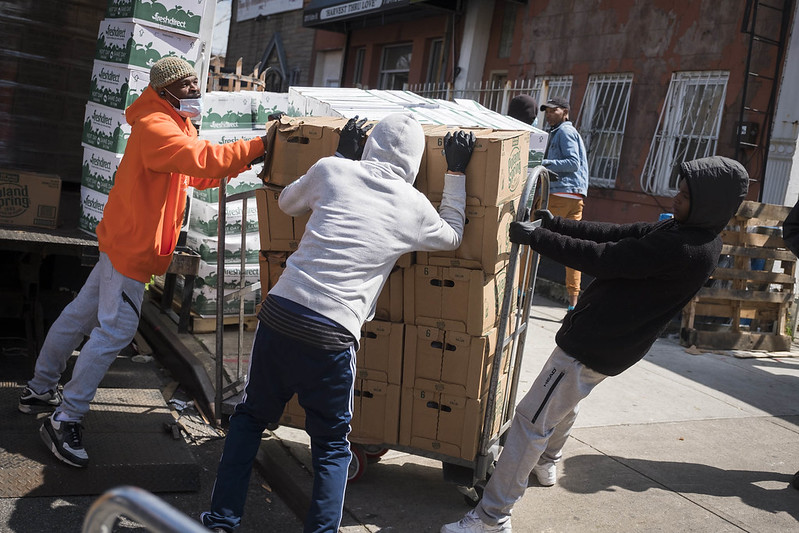It's Time to End Substandard Working Conditions in Home Care

Taking care of people at their homes (photo: Michael Appleton/Mayoral Photography Office)
The rapidly aging population in the United States, combined with the global pandemic, has brought the issue of home care to national headlines. As evidenced by President Biden’s proposal of a standalone $1.8 trillion bill dedicated to caregiving, it’s clear the government is looking to address challenges in long-term care, especially as the sector faces one of its most urgent labor shortages ever. Against the backdrop of Labor Day – a time to celebrate workers and recognize the importance of unions in fighting for better working conditions – there is no better time to reform our home care system for workers and, ultimately, patients.
Today, more than 800,000 individuals remain on the Medicaid waiting list for home care, a number that is only expected to increase in the future. Just consider seven out of 10 of us will need long-term care at some point in our lives. Yet, despite these increases, home care wages have steadily decreased over the last decade. In 2006, home care workers earned approximately 150% of the state minimum wage on average. Today, the same caregivers receive the minimum wage or slightly above. More than one in seven low-wage workers in New York City is a home care worker. One in four workers live below the federal poverty line, and more than half rely on some form of public assistance to make ends meet. These low wages have led to chronic staffing shortages in the industry (17% of home care positions were left unfilled between 2018-2019) and a projected overall workforce shortage crisis of 83,000 workers by 2025.
At the root of this is a systemic devaluation of care work. Traditionally, this labor is undertaken by women, particularly women of color, and government Medicaid reimbursement rates have historically devalued these workers. Home care work is in fact highly skilled work and, as we have seen during this pandemic, often dangerous and heroic. By treating it that way and changing the system accordingly, we can make care work dignified, address the workforce shortage, create a thriving care economy and better serve patients.
In New York State specifically, the two most critical issues in the home care sector are chronic low wages and 24-hour live-in cases, where home care workers stay in patient homes for 24 hours. During this time, workers care for the patient for 13 hours, with the other 11 hours left unpaid for sleep and meals. With approximately 11,000 24-hour cases in New York alone, staffed by 33,000 home care workers, this is an issue that impacts far too many. However, for many in the home care sector, this disparity doesn’t come as a surprise, as nonprofits have historically faced inadequate state compensation, unfunded mandates, and longstanding labor negotiations. In short, state law ties non-profit home care agencies to low Medicaid reimbursement rates and antiquated rules that harm both patients and workers.
The state has continually chosen to ration care rather than allocating the required $1 billion in Medicaid to provide better wages to workers with 24-hour shifts and higher quality care for patients. As CEO of nonprofit organizations that care for 3,000 home care patients and have a 56-year legacy of providing educational, social, and community services for Asian American and immigrant New Yorkers, I understand the impact these outdated policies have on workers, patients, and families alike.
I’m often left wondering: Why did lawmakers create a system that restricts equal pay for equal work? Labor Day is meant to commemorate the contributions workers have made to the strength, prosperity, and well-being of this country – and yet, many of those who care for others are not being cared for by our government.
With the Biden Administration’s long-term vision for home care reform already paving the way for new bills on this issue, we as a community must seize this momentum and end 24-hour shifts. To do so, the New York state government must first create a system by which home care workers receive full compensation for every hour at a patient’s home on call for needed assistance, which starts by transitioning away from 24-hour shifts in favor of two 12-hour split shifts. However, no single entity can make this change alone.
Together, we can put enough pressure on officials in Albany to pass one bill -- A3145, sponsored by Assemblymember Harvey Epstein -- that would end 24-hour shifts in favor of two 12-hour split shifts, as well as another, Fair Pay for Home Care -- S5374/A6329, sponsored by Senator Rachel May and Assemblymember Dick Gottfried -- to raise home care worker pay to 150% of the highest area minimum wage across the state. Both pieces of legislation would allow for long-term investments in home care workers, so they can provide the best care possible for patients, such as new training structures, restructured certification, mentor programs, and more.
If the COVID-19 pandemic has shown us anything, it’s the critical role healthcare professionals provide during times of significant need. For many years, these essential skilled workers have devoted their time and energy to supporting an increasingly aging population. This Labor Day, it’s time for us all to support them and advocate for meaningful, systemic change to build a more just and caring economy.
***
Wayne Ho is President & Chief Executive Officer of the Chinese-American Planning Council, Inc. On Twitter @cpc_nyc.
***
Have an op-ed idea or submission for Gotham Gazette? Email This email address is being protected from spambots. You need JavaScript enabled to view it.
This Labor Day, Celebrate Workers By Ensuring Their Safety

Workers (photo: Michael Appleton/Mayoral Photography Office)
For the past 18 months, essential workers have heroically worked in hospitals, driven buses and subways, and kept grocery stores stocked as the deadly pandemic ebbed and flowed.
It is not an overstatement to say that our city and state could not have functioned without these heroes. The toll on these men and women and their families was devastating, with thousands of frontline workers dying from COVID-19 or losing their jobs while many others were able to stay home and work safely.
Unsurprisingly, Black, Latino, and immigrant workers were hit the hardest, once again revealing long-standing inequalities in our society.
While the city rightfully lauded essential workers as heroes, with nightly applause and a parade, words don’t save lives or jobs. As we reflect on Labor Day this year, we must remember that it takes real action on both the federal and state level to prevent significant, deadly disparities between workers.
The pandemic highlighted the importance of strong federal worker safety rules -- and what can go wrong when the government falls down on the job. All across the country there were cases of big corporations putting their employees in incredibly dangerous situations that led to unnecessary deaths, such as at meatpacking plants, where work often continued even on the deadliest days.
These are the exact types of issues that the Occupational Safety and Health Administration (OSHA) was created to address, but during the Trump years it was gutted and underfunded, with record low levels of inspectors. The agency also failed to issue any robust guidelines to protect workers during the pandemic.
But even with an expanded OSHA under the Biden administration, we cannot rely solely on the federal government to step in and protect New Yorkers. We must have strong state laws backed by an open and accessible civil justice system.
The New York HERO Act, which was signed into law but is still awaiting full implementation, mandates safety protocols in workplaces in response to the pandemic, including PPE and social distancing measures. These types of rules set a clear standard that other states, and the federal government, can follow.
Beyond pandemic protections, New York’s scaffold safety law is another example of how New York supports workers. This law makes those who control a construction site liable for fall-related injuries that occur when they fail to provide the proper safety equipment. This ensures that men and women who work in construction can hold their employers accountable if they fail to maintain a safe worksite.
The civil justice system offers a powerful way to hold negligent actors accountable. The threat of financial and legal penalties often forces change when employers refuse to do the right thing.
The Legislature has passed other important laws that strengthen the civil justice system, such as a bill that would make it easier to bring cases against companies that harm New Yorkers, even if the wrongdoing happens outside the state. That bill will be sent to the Governor at some point later this year to be signed into law.
These laws are essential to providing a civil justice system that is open and accessible – no matter your age, income, or background. We must continue to examine similar legislation that closes the loopholes that prevent New Yorkers from having their day in court.
In the wake of the pandemic’s destruction, we need to make sure we are passing laws that protect working men and women as well as the civil justice system that allows them to hold powerful employers accountable.
***
Halina Radchenko is president of the New York State Trial Lawyers Association. Charlene Obernauer is executive director of New York Committee for Occupational Safety and Health.
***
Have an op-ed idea or submission for Gotham Gazette? Email This email address is being protected from spambots. You need JavaScript enabled to view it.
Why You Should Support Your Local Nonprofits and Help Them Fight for More on International Day of Charity

Nonprofit New York at work (photo: Ed Reed/Mayoral Photography Office)
In an effort to increase and enhance social responsibility worldwide, the United Nations General Assembly marked September 5 as the International Day of Charity. This day serves to encourage community members everywhere to show support for charitable causes including the efforts of local nonprofit organizations.
From climate change and systemic racism to poverty and homelessness, nonprofits are tasked with some of the most difficult and ingrained challenges of our time. Yet nonprofits in the human services sector are historically underfunded and undervalued. On this International Day of Charity, Westhab — the nonprofit I’m honored to lead as president and CEO — calls for a future where communities support and value nonprofits as an equitable partner to government and the business community. It is essential that organizations such as ours are shown the support that is commensurate with the critical impact we are making.
The devaluation of the nonprofit sector isn’t the work of any one unit of government or really a deliberate strategy at all. Westhab is fortunate to have strong partnerships with the County of Westchester, New York City, New York State, and many local governments and businesses that see great value in public-private partnerships to meet pressing needs. Unfortunately, in our society, the nonprofit sector is not valued in line with its importance.
Charitable giving provides an opportunity for society to alleviate the pain and suffering of humanitarian crises such as homelessness. Through charitable giving, nonprofits across the country can work towards making a difference in marginalized and underprivileged communities every day. If people take today to recognize the difference even one small action can make, and how that action can be compounded by others, we can make a real difference in creating a more inclusive, resilient, and healthy society.
Intertwined in the nonprofit sector’s history of being undervalued are issues of race and gender equity. The nonprofit sector is dominated by women and people of color, because much of the work we tackle came out of settlement houses, orphanages, and other charitable work—admirable things for women to do, often as volunteers, at a time when men were the sole breadwinners. Women are the backbone of the social work profession, often women of color who themselves have faced economic exclusion and systemic obstacles to success. By undervaluing the importance of the nonprofit human services sector, we also do a disservice to the essential contributions of historically marginalized groups.
Westhab’s staff on the front lines, such as our security professionals and our janitorial staff, form the essential team that admirably staffed homeless shelters and supportive housing residences in the height of the COVID-19 pandemic. Even so, they are often ascribed the label of “unskilled” and valued as such. However, I see the work that these people do every day. It takes incredible skill, in addition to fortitude and passion, to deliver on Westhab’s promise.
The systemic austerity of the sector has been recently dubbed the “nonprofit starvation cycle.” Public and private funders of nonprofits provide insufficient administrative support to operate organizations. Nonprofits often undercut each other with lowball budgets to win the precious few grants and contracts that are available. Our sector has often taken great pride in “doing more with less.” However, this is not the way forward. We are at a place where we need more.
The results of the starvation cycle include overtasked employees, lower wages, and high employee turnover, none of which exemplify the values of our sector or help organizations (or governments) achieve their mission. It is also incredibly inefficient, and we spend far too much time scrambling to fill gaps when we should be building systems and infrastructure. It is past time to create a new and more equitable sector.
Fortunately, there is reason for hope. Westhab is a member of the Human Services Council, which has fought admirably and successfully for New York City to increase indirect cost rates to nonprofits to account for the true cost of operations. Westhab is also a member of Nonprofit Westchester, which is working on the same path and building great momentum around nonprofit employee wages. Overall, our government partners and private funders have been supportive and understand the need for change.
I am extremely proud of Westhab, which has grown and evolved in recent years to meet the community’s urgent needs and widen the pathway from homelessness to permanent housing. However, I long for the day when every member of our team is paid a living wage and is valued at the true level of their contributions to our community. I know this is possible. Our sector does incredible things with less. Imagine what we could do with more.
***
Richard Nightingale is President and CEO of Westhab, Inc. On Twitter @RichWesthab.
***
Have an op-ed idea or submission for Gotham Gazette? Email This email address is being protected from spambots. You need JavaScript enabled to view it.




